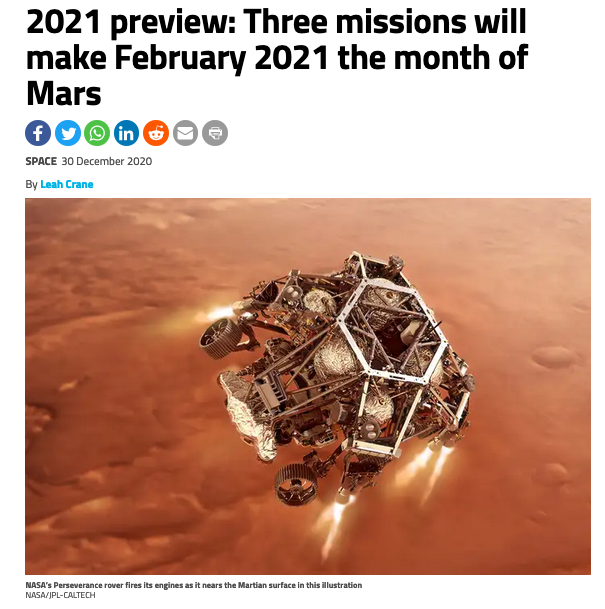
FOR Mars fans, February will be an exciting month. The Red Planet is getting three visitors from Earth, which all took off in July 2020. The Hope orbiter, the first Mars mission from the United Arab Emirates, was first to launch, followed by China’s Tianwen-1 mission, which includes an orbiter, a lander and a rover. The last to take off was NASA’s Perseverance rover.
Hope will be the first to arrive at Mars, skimming into orbit around 9 February. It will check its instruments and then start taking scientific measurements in May. The orbiter will observe the atmosphere, with a focus on how gases are able to escape and float away into space – the same process that took early Mars from a wet world with a thick atmosphere to the arid planet we see today.
“The Hope probe will be able to give us a unique perspective when it comes to the Martian atmosphere, because it’s the first mission that’s been able to combine global coverage, different wavelengths and variation over time,” says Hessa Al Matroushi, the mission’s science and data analysis lead. “We’re looking into the gaps in the understanding of the Martian atmosphere and trying to fill in those gaps.”
Tianwen-1 will probably arrive next, although the exact date hasn’t yet been announced. Once the spacecraft is in orbit, a landing pod will detach and head towards the surface. After it lands, a little ramp will slide out and the rover will unfurl its solar panels and wheel away.
The orbiter will help relay data from the rover back to Earth, but it also has its own instruments to observe Mars’s atmosphere and surface. The rover carries a radar system to penetrate about 100 metres beneath the surface, instruments to analyse samples of Martian dust, a magnetic field detector and a set of cameras.
Perseverance will probably be the last of the three missions to arrive, reaching Mars on 18 February. The landing will look nearly identical to that of the Curiosity rover in 2012, with a key difference: a new navigation system that will take pictures as the rover nears the surface to let the lander’s computer pick the safest spot to land.
“NASA has nicknamed it ‘Neil Armstrong for Mars’, because it uses cameras to image the landing site so it can divert away from dangerous targets,” says Briony Horgan atPurdue University in Indiana. “That’s what Neil Armstrong did on Apollo 11, because the landing site they had chosen turned out to be unsafe, so he had to look through this little window and find anew, safer landing site by eye.”
“The Hope probe will be able to give us a unique perspective when it comes to the Martian atmosphere”
This landing system means we don’t know exactly where Perseverance will touchdown. After it does reach the surface, though, the rover’s prime directive is to collect and store samples to be picked up and returned to Earth by a planned later mission. Perseverance will also take its own samples to look for signs of ancient life. Researchers will be able to do more detailed studies on the samples that come back to Earth.
Although these three missions will reach Mars at about the same time, there isn’t much that they can do to work together. “The three missions will be going to very different places and doing different things,” says Horgan. “All of this data together will help us build a much better picture of the planet as a whole.”
Read more: https://www.newscientist.com/article/mg24833141-700-2021-preview-three-missions-will-make-february-2021-the-month-of-mars/#ixzz6m5RVIKuk
